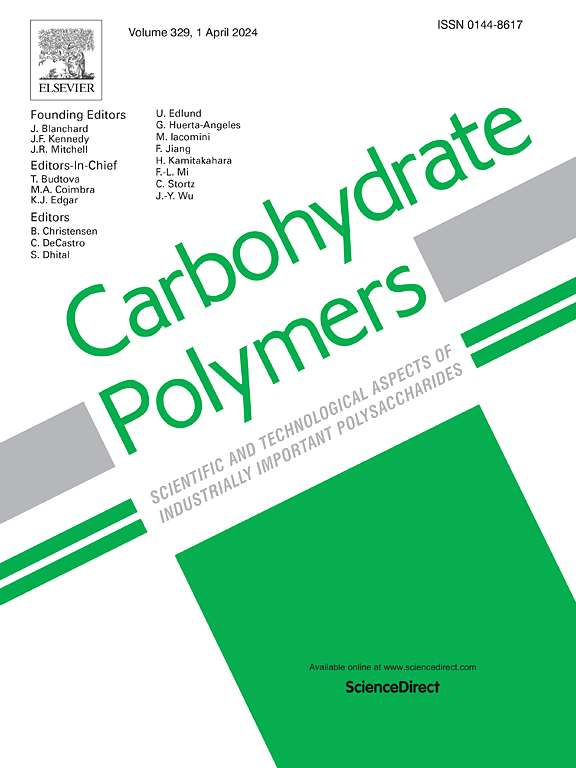Investigating the interactions between a poloxamer and TEMPO-oxidised cellulose nanocrystals
IF 12.5
1区 化学
Q1 CHEMISTRY, APPLIED
引用次数: 0
Abstract
Cellulose nanocrystals (CNCs) have emerged as promising, sustainable materials, with applications in sensors, coatings, pharmaceuticals, and composites. Their modification with block copolymers such as PEO-PPO-PEO triblock copolymers of the Pluronic family has been attempted many times in the literature, with claims that such modification would happen by an anchor(PEO)-buoy(PPO)-anchor(PEO) mechanism. However, there is much disagreement in the literature on this. We herein physically adsorbed Pluronic F127, a nontoxic triblock copolymer poloxamer, comprising hydrophilic polyethylene oxide (PEO) and hydrophobic polypropylene oxide (PPO) blocks, onto the surface of TEMPO oxidised CNCs by simple mixing in an aqueous medium. The adsorption of F127 onto the surface of these CNCs was successful and persistent even after solubilisation. The thermal stability of modified TOCNCs increased (by ∼19 °C) compared to their neat and oxidised counterparts. F127-TOCNC suspensions exhibited comparable viscosity to their neat and oxidised counterparts without premature gelation of F127. NOESY NMR observations showed that PPO blocks are more proximal to the TOCNC than the PEO blocks. AFM and QCM-D analyses supported the formation of a rigid, thin layer of block copolymer surrounding the TOCNC. A degree of modification (7 %) was achieved, even after washing, proving that adsorption is persistent and mainly irreversible.
研究波洛沙姆和tempo氧化纤维素纳米晶体之间的相互作用。
纤维素纳米晶体(CNCs)已经成为一种有前途的可持续材料,在传感器、涂料、制药和复合材料中得到了应用。用嵌段共聚物(如Pluronic家族的PEO-PPO-PEO三嵌段共聚物)对它们进行改性已经在文献中进行了多次尝试,声称这种改性可以通过锚(PEO)-浮标(PPO)-锚(PEO)机制进行。然而,在这方面的文献中有很多分歧。我们在此通过在水介质中简单混合,将Pluronic F127(一种无毒的三嵌段共聚物poloxamer,由亲水性聚乙烯氧化物(PEO)和疏水性聚丙烯氧化物(PPO)嵌段组成)物理吸附到TEMPO氧化的cnc表面。即使在溶解后,F127在这些cnc表面的吸附也是成功的和持久的。与纯TOCNCs和氧化TOCNCs相比,改性TOCNCs的热稳定性提高了(约19°C)。F127- tocnc悬浮液的粘度与其整洁和氧化的对偶物相当,没有F127的过早凝胶化。NOESY NMR观察表明,PPO区块比PEO区块更接近TOCNC。AFM和QCM-D分析支持在TOCNC周围形成刚性的薄层嵌段共聚物。即使在洗涤后,也实现了一定程度的改性(7%),证明吸附是持久的,主要是不可逆的。
本文章由计算机程序翻译,如有差异,请以英文原文为准。
求助全文
约1分钟内获得全文
求助全文
来源期刊

Carbohydrate Polymers
化学-高分子科学
CiteScore
22.40
自引率
8.00%
发文量
1286
审稿时长
47 days
期刊介绍:
Carbohydrate Polymers stands as a prominent journal in the glycoscience field, dedicated to exploring and harnessing the potential of polysaccharides with applications spanning bioenergy, bioplastics, biomaterials, biorefining, chemistry, drug delivery, food, health, nanotechnology, packaging, paper, pharmaceuticals, medicine, oil recovery, textiles, tissue engineering, wood, and various aspects of glycoscience.
The journal emphasizes the central role of well-characterized carbohydrate polymers, highlighting their significance as the primary focus rather than a peripheral topic. Each paper must prominently feature at least one named carbohydrate polymer, evident in both citation and title, with a commitment to innovative research that advances scientific knowledge.
 求助内容:
求助内容: 应助结果提醒方式:
应助结果提醒方式:


